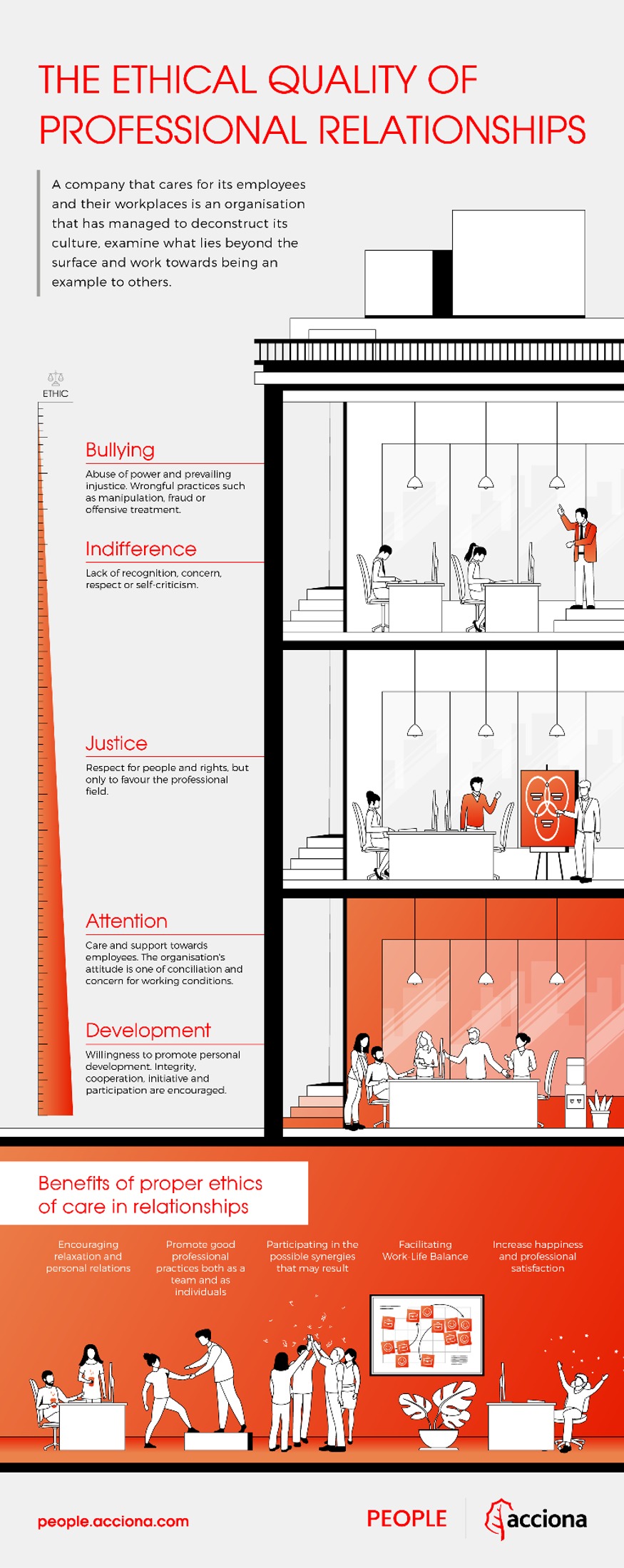We often think about the quality of products, and the quality of processes. We work together to improve them. However, we often forget another kind of quality: the standard of our relationships. According to the results of one of the oldest longitudinal studies, initiated in the 1930s by Harvard University, one of the factors that best explains a person’s quality of life is not his income, or his level of education, but the quality of his relationships, in other words, relational quality.
In organisations, as in any type of social relationship, it is important to reflect on the predominant type of relationship quality. Little work has been done in this area regarding ethics in organisations (the one concerning the care of their employees). However, Dr. Melé, professor at IESE Business School, recently published an article in the Journal of Business Ethics [1] that gives us tools to reflect on the quality of relationships in organisations. He proposes five possible levels of relationship quality, which he calls Human Quality Treatment. These five levels are abuse, indifference, justice, care and development.
The five levels of the ethics of care within organizations
Bullying. Mistreatment is the lowest level of relational quality. It involves an abuse of power and a situation of flagrant injustice in a relationship. Examples of abuse that can occur in organisations are labour exploitation, intimidation or sexual harassment, personal treatment that is harmful or offensive, irresponsible and arbitrary use of authority, manipulation of persons, decisions based on unfair discrimination, persuasion or coercion into participation in fraudulent practices, or failure to take action to prevent abuse of power or misconduct.
Indifference. Indifference is the second lowest level of relational quality. It implies disrespectful treatment due to a lack of recognition and concern for the people who make up the organisation. Among different forms of indifference, we find treatment of people without appreciation beyond the condition of a resource, that is, people are treated as means and not as end. Examples of indifference would also include considering only the legal and business consequences in human relations, ordering harshly, speaking without respect, responding without courtesy, not giving recognition when due, and not seeking forgiveness when one is aware of a mistake made.
Justice. Justice is the average level of relational quality. It means respecting people and their rights, but forgetting that there is more to it than just that. A relationship based on justice is one that provides recognition and respect for human dignity and rights, keeps its word and the fulfilment of agreements and contracts, behaves fairly in remuneration and performance evaluation, acts fairly in hiring and firing processes, communicates with transparency and truthfulness, acts in good faith and loyalty, respects the privacy of employees, and shows willingness to resolve and change unfair situations.

Care. Care is at the top of relational quality. It involves a concern for people’s legitimate interests and the support necessary for problems to be solved. We find ourselves at this level when the organisation shows sensitivity in solving the problems of the people who make up the organisation, when it shows permanent concern for improving working conditions, when it shows tolerance for the faults and errors of employees, when it facilitates work-life balance and when it maintains a conciliatory attitude.
Development. Development is the highest level of relational quality. It takes place when there is a will to favour human development, mutual esteem and reciprocity in the relationship. A high-quality relationship arises when there is true esteem for the collaborators, when integrity and virtuous behaviour within the organisation is favoured, when there is a spirit of service and cooperation, when initiative, creativity, participation, a sense of responsibility and commitment and mutual esteem are encouraged, and when each person’s talents are known and work is done to try to maximise them.
What are the ethics of your organization?
As Dr. Melé rightly points out, it is necessary for each organization to make a good self-diagnosis of the relational quality that prevails in it. It would be interesting not only to know what is the most common type of relationship that exists in our organization, but also what type of relationship we would like to foster. Are we moving to the third level (justice) and do we want to reach the fifth level (development)?
It would also be very interesting to know the differences between the perception among employees and management of the type of relationships that exist. It could be that they don’t fit together: while some think that they are living in a situation of indifference, others may perceive that justice rules. Finally, one could reflect on whether the relational quality towards all the people who make up the organization is the same. It could be possible that some people perceive relational quality as something between care and development, while others in other divisions or hierarchical positions of the same organisation, perceive indifference or justice. We hope that tools and classifications such as those provided by Dr Melé will help organisations to reflect on relational quality, and how to improve it.
Sources:


